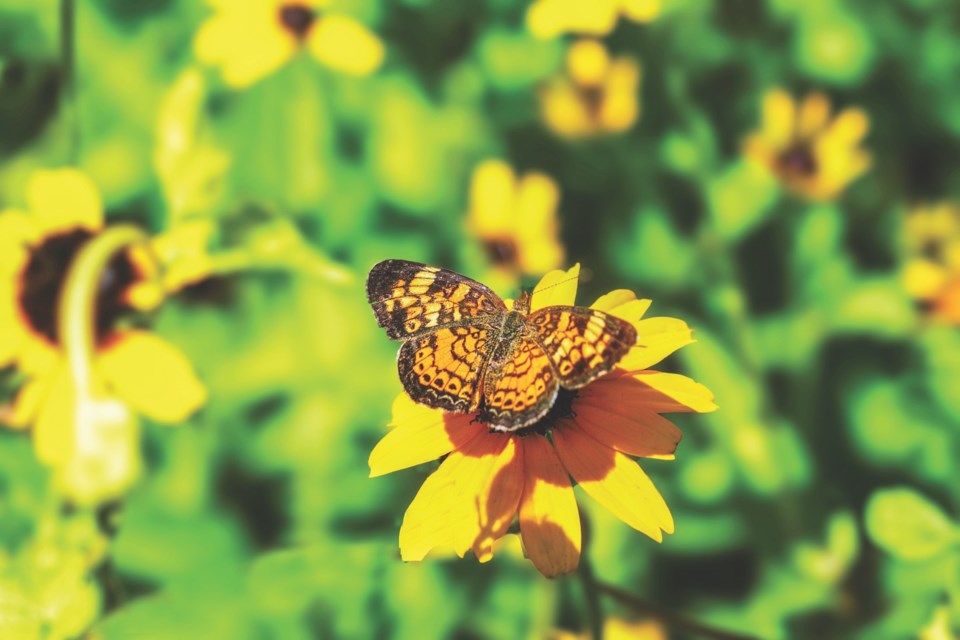Scientists estimate we have approximately 20,000 varieties of insects (www.insectsofalberta).
Another website, www.roguevalleynursery.com, estimates between 97%-99% of insects are either harmless or beneficial.
Beneficial insects pollinate flowers, vegetables, and fruit trees. Others help to keep pests under control. Many insects are food for birds. Unfortunately, many pesticides and lawn chemicals kill all insects, seriously impacting the productivity of our gardens, harming our environment, and reducing the number of song birds.
Some beneficial insects prey on garden pests. Parasitic flies and wasps lay eggs on the larvae of butterflies, moths, beetles, sawflies, and other insects; the larvae eat the host and the host eventually dies. Lady beetles and their larva and lacewings eat aphids. Beetles eat insect eggs, larva, adult mites, aphids, and other pests. The gnat and its larva control spider mites. Wasps eat aphids, flies, caterpillars, and other insects. The hover fly lays its eggs in the middle of an aphid colony and when they hatch the larvae eat the aphids.
Have you ever wondered why your plum tree was full of blossoms, but bore no fruit? Where were the pollinators?
There are many pollinators in the urban garden. In Alberta, there are over 300 species of native bees, with at least 8 main species--including bumble, mason, digger, cuckoo, miner, masked, and leafcutter bees. Other pollinators include hover flies, butterflies, moths, wasps, flies, ants, midges, beetles, and, believe it or not, mosquitos.
Bees are the most important, ensuring your fruit trees and berry bushes fruit, your flowers seed, and squash and cucumbers set. To attract bees, provide food in the form of a wide variety of flowers, fruit trees, and berry bushes. In the spring, pollinators are attracted to poppies, fruit trees and berry bushes, lilacs, and pasque flowers. In the summer bees like the butterfly bush, coneflowers, dahlia, fireweed, phlox, sedum, and sunflower. In the fall bees go to aster, goldenrod, and back eyed-Susan.
Solitary bees such as the mason bee are important pollinators. They live alone, do not sting, and make their nests in small cavities in mid to late summer. The eggs hatch in the spring.
A bee hotel provides a place for solitary bees to lay their eggs. The simplest version is an 8-inch-deep box with sides, a back, a roof to keep out moisture, and an open front. In the box will be tubes of paper or cardboard, or rounds of wood with holes of many different diameters drilled into the rounds in which different sizes of solitary bees will lay their eggs. Do not use plastic straws or tubes; moisture is trapped and the eggs or pupae will mould and rot. Look up different designs on the internet.
Attach the hotel to a fence or post at least three feet above the ground, facing south or south-east. Clean out the tubes and holes each spring with a pipe cleaner after the eggs have hatched and the bees have emerged. If you don’t, your hotel becomes a haven for mites, fungus, and other parasites and you will have dead bees.
Another garden delight are pretty butterflies, in oranges, reds, mauves, and even whites. There are 26 varieties in Alberta ranging from the White Cabbage, Tiger, Swallowtail, Mourning Cloak, Fritillary, to the Melissa Blue. Except for the cabbage butterfly they do little damage to your garden. Butterflies need native plants to feed on and their lay eggs on. Because they taste and smell with their feet, they like flat petal plants, such as bee balm, butterfly bush, lavender, blanket flower, Shasta daisy, black-eyed Susan, and yarrow. Butterflies are also pollinators.
If you avoid harmful pesticides, your fruit trees and berry bushes will fruit, your flowers will seed, and your squash and cucumbers will set. Nature is magic.
For more, see learningbygrowing.com
https://learningbygrowing.com/bees-butterflies-and-other-beneficial-insects
Charles Schroder gardens in the Edmonton area.




